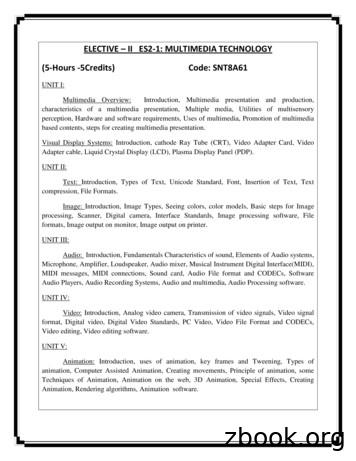Chapter 2 Multimedia Systems - FTMS
MMGD0101INTRODUCTION TO MULTIMEDIAChapter 2Multimedia Systems
Definition of MultimediaSystemA Multimedia System is asystem capable ofprocessing multimedia dataand applications. It ischaracterized by theprocessing, storage,generation, manipulationand rendition of Multimediainformation.
Definition of MultimediaSystemThe differences between print and multimedia: Different modes of display Interactivity and involvement of participants inmultimedia systems Ease of distribution Authority of document
Characteristics of aMultimedia SystemsA Multimedia systems has four basiccharacteristics: Multimedia systems must be computercontrolled. Multimedia systems are integrated. The information they handle must berepresented digitally. The interface to the final presentation of mediais usually interactive.
Characteristics of aMultimedia SystemsComputer Controlled Producing the content of the information – e.g. byusing the authoring tools, image editor, sound andvideo editorStoring the information – providing large and sharedcapacity for multimedia information.Transmitting the information – through the network.Presenting the information to the end user – makedirect use of computer peripheral such as displaydevice (monitor) or sound generator (speaker).
Characteristics of aMultimedia SystemsIntegrated All multimedia components (audio, video, text,graphics) used in the system must be somehowintegrated.Every device, such as microphone and camera isconnected to and controlled by a single computer.A single type of digital storage is used for all mediatype.Video sequences are shown on computer screeninstead of TV monitor.
Characteristics of aMultimedia SystemsInteractivity Level 1: Interactivity strictly on information delivery.Users select the time at which the presentationstarts, the order, the speed and the form of thepresentation itself.Level 2: Users can modify or enrich the content ofthe information, and this modification is recorded.Level 3: Actual processing of users input and thecomputer generate genuine result based on theusers input.
Characteristics of aMultimedia SystemsDigitally Represented Digitization: process involved in transforming ananalog signal to digital signal.
Challenges for MultimediaSystemsThe key issues multimedia systems needto deal with here are: How to represent and store temporalinformation.How to strictly maintain the temporalrelationships on play back/retrieval.What process are involved in the above.
Desirable Features for aMultimedia System Very High Processing Power Multimedia Capable File System Data Representations/File Formatssupport multimedia Efficient and High I/O Special Operating System Storage and Memory Network Support Software Toolsthat
Components of aMultimedia SystemCapture Devices Video CameraVideo RecorderAudio MicrophoneKeyboardsMice Graphics tablets3D input devicesTactile sensorsVR devicesDigitizing/SamplingHardware
Components of aMultimedia SystemStorage Devices Hard disk drive Zip drive Compact Disc Digital Versatile Disc Bluray Disc
Components of aMultimedia SystemCommunication Networks Ethernet Token Ring Fiber Distributed DataInterface (FDDI) Asynchronous TransferMode Intranets Internets
Components of aMultimedia SystemComputer Systems Desktop computerProcessorRAMDisplay card Sound card Capture card
Components of aMultimedia SystemDisplay Devices High resolution monitor High quality speakers Color printer Projector
Class ActivityExerciseGroup discussion. You are require to set up a MultimediaSystems. Identify the components and budget to set upthe system. Present to the class.
Multimedia Systems Computer Controlled Producing the content of the information –e.g. by using the authoring tools, image editor, sound and video editor Storing the information –providing large and shared capacity for multimedia information. Transmitting the information –through the network.
Part One: Heir of Ash Chapter 1 Chapter 2 Chapter 3 Chapter 4 Chapter 5 Chapter 6 Chapter 7 Chapter 8 Chapter 9 Chapter 10 Chapter 11 Chapter 12 Chapter 13 Chapter 14 Chapter 15 Chapter 16 Chapter 17 Chapter 18 Chapter 19 Chapter 20 Chapter 21 Chapter 22 Chapter 23 Chapter 24 Chapter 25 Chapter 26 Chapter 27 Chapter 28 Chapter 29 Chapter 30 .
TO KILL A MOCKINGBIRD. Contents Dedication Epigraph Part One Chapter 1 Chapter 2 Chapter 3 Chapter 4 Chapter 5 Chapter 6 Chapter 7 Chapter 8 Chapter 9 Chapter 10 Chapter 11 Part Two Chapter 12 Chapter 13 Chapter 14 Chapter 15 Chapter 16 Chapter 17 Chapter 18. Chapter 19 Chapter 20 Chapter 21 Chapter 22 Chapter 23 Chapter 24 Chapter 25 Chapter 26
Introduction to Multimedia (continued) Multimedia becomes interactive multimedia when a user is given the option of controlling the elements. Interactive multimedia is called hypermedia when a user is provided a structure of linked elements for navigation. Multimedia developers develop multimedia projects.
Learn the phases involved in multimedia planning, design and production; Be able to use various multimedia authoring tools Be able to design and create interactive multimedia products Develop competencies in designing and producing instruction-al multimedia Apply contemporary theories of multimedia learning to the development of multimedia .
DEDICATION PART ONE Chapter 1 Chapter 2 Chapter 3 Chapter 4 Chapter 5 Chapter 6 Chapter 7 Chapter 8 Chapter 9 Chapter 10 Chapter 11 PART TWO Chapter 12 Chapter 13 Chapter 14 Chapter 15 Chapter 16 Chapter 17 Chapter 18 Chapter 19 Chapter 20 Chapter 21 Chapter 22 Chapter 23 .
MULTIMEDIA TECHNOLOGY UNIT – I Multimedia an overview: Introduction The word ‗multimedia‘ comes from the Latin words multus which means ‗numerous‘ and media which means ‗middle‘ or center. Multimedia therefore means ‗multiple intermediaries‘ or ‗multiple means‘. Multimedia
MULTIMEDIA V.S MULTIMEDIA INTERAKTIF Multimedia adalah penggunaan berbagai jenis media (teks, suara,grafik,animasi,danvideo). Multimedia interaktif menambahkan elemen ke-enam yaitu aspek interaktif Pada multimedia non-interaktif, user bertindak pasif dan menyaksikan adegan demi adegan secara berurut
vation in automotive retail is the imperative – and the time to get started is now. Against this backdrop and based on our extensive research and analyses (Textbox 2), we will provide a comprehensive perspective on three key questions that are currently a top priority for automotive OEMs and dealers: 1. Why exactly is the traditional automotive retail model so severely under pressure at .























